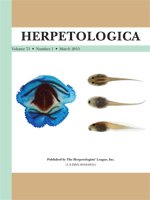The decline in snake populations has been attributed primarily to anthropogenic disturbances, including habitat destruction and fragmentation. We radio-tracked Northern Pinesnakes (Pituophis m. melanoleucus) in a military Target Zone and in the surrounding undisturbed buffer zone at the Warren Grove Gunnery Range in the New Jersey Pine Barrens, USA, to examine differences in spatial movement patterns and behavior. There were no differences in home range size (X¯ = 60.0 ± 32.7 ha), core activity area (X¯ = 10.6 ± 8.2 ha), range length (X¯ = 1294.8 ± 32.7 m), or mean distance traveled per day (X¯ = 65.2 ± 30.1 m) across all snakes, or between sexes (male n = 13, female n = 11), or location within (n = 13) or outside (n = 11) of the Target Zone. However, there were differences between tracking years. Northern Pinesnakes in 2005 and 2006 (n = 13) traveled greater total distance and mean distance per day and had larger home ranges compared to snakes radio-tracked in 2003 and 2004 (n = 11). In 2005 and 2006, snakes in the Target Zone traveled longer distances compared to snakes outside the Target Zone. Pinesnakes used both the Target Zone and undisturbed buffer zone for mating, nesting, foraging, and hibernating. Although the Target Zone was disturbed regularly, the open-canopied landscape, cover availability, and sandy soils maintained habitat for Northern Pinesnakes. Our data indicate that the military disturbance had little impact on the spatial ecology of Northern Pinesnakes; the disturbed area supported enough natural habitat features used by Northern Pinesnakes and was surrounded by a large tract of undisturbed landscape. These data can aid in developing mitigation and conservation strategies where the habitat of Northern Pinesnakes is threatened by development, in particular, across other military installations, which commonly overlap with the occurance of Northern Pinesnakes.
How to translate text using browser tools
1 March 2015
Spatial Ecology of Northern Pinesnakes (Pituophis m. melanoleucus) in Disturbed and Undisturbed Habitats in the New Jersey Pine Barrens
Ronald M. Smith,
James R. Spotila,
Walter F. Bien
ACCESS THE FULL ARTICLE

Herpetologica
Vol. 71 • No. 1
March 2015
Vol. 71 • No. 1
March 2015
animal movement
behavior
conservation
disturbance
Military land
radiotelemetry
Warren Grove Gunnery Range




